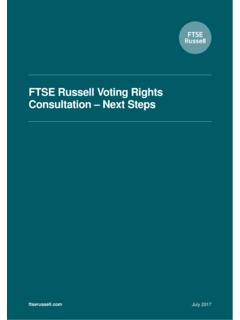Transcription of Review of the UK’s Drugs Classification System - a …
1 1 Review of the UK s Drugs Classification System - a public consultation . Home Office Crime and drug Strategy Directorate May 2006 [Note (July 2010): This a draft of a consultation paper which was not, in fact, approved for publication in 2006. The draft is being released under Freedom of Information legislation.] 2 CONTENTS Foreword 3 Purpose of the Review 4 Historical Context 6 The Current Classification System 8 and Schedules How is a drug s Harm Measured? 13 Legal and Socially Accepted Substances 16 International Controls 18 International Comparisons 20 Options for Consideration 24 Application, Impact on Regulation 28 Contacts for Responses 29 Code of Practice on consultation 30 Annex A - EU Control System 32 Annex B US Control System 40 Annex C NZ Control System 46 3 Ministerial The current arrangement of classifying controlled Drugs through a three-tier System ( Class A, B and C) was established by the Misuse of Drugs Act 1971.
2 Drugs are placed in these three classes to reflect their relative harms andthe maximum penalties which offences relating to their cultivation, possession and supply attract. Historically, there has been very little movement of Drugs between the three classes since the Misuse of Drugs Act was introduced in 1971. However, the Classification System , and the way in which it is operated, lacks clarity, and has led to prolonged disagreements over whether certain Drugs have been classified correctly according to their relative harms. This has been particularly true in the case of cannabis, the reclassification of which from a Class B to a Class C drug in January 2004 resulted in a degree of public confusion as to the Government s view of its harmfulness and illegality. When the Home Secretary announced his decision to retain cannabis as a Class C drug on 19 January 2006, he said that he would be reviewing the Classification System operated under the Misuse of Drugs Act.
3 This consultation paper represents the first stage of that Review . It will be augmented by a series of consultation events organised by the Home Office during the consultation period. Ministers will consider the outcome very carefully before announcing a decision on the way forward in the Autumn of 2006. To set this Review in its proper context, it is worth emphasising that the patterns of drug misuse in the United Kingdom have changed markedly in the 35 years since the 1971 Act was passed in Parliament. The Government s drug Strategy is beginning to have a real impact in tackling drug misuse; the associated harms are now beginning to reduce. But there is much more that we need to do, including getting clear messages across about the harms that Drugs cause. Having a clear and readily understood Classification System on which to base messages which are realistic, relevant and credible is essential.
4 The misuse of Drugs is a global issue that requires a concerted international response. The UK takes its international responsibilities on Drugs matters very seriously and decisions taken following this consultation will be entirely consistent with those responsibilities. In other words, any new Classification System which may be adopted would need to be consistent with the UK s obligations under the relevant UN Conventions. 4 Purpose of the The UK System of classifying Drugs according to their harmfulness has been in place since the introduction of the Misuse of Drugs Act in 1971. Over the past 35 years patterns of drug use have changed quite significantly, and recent debates about the Classification of certain Drugs , especially cannabis, have led to questions about the clarity of the current System and whether it remains fit for purpose.
5 Drugs are classified in order to provide direction to courts for penalties for different Drugs . The Classification System is in part based on a distinction between the effects and dangers of different Drugs to individuals and society and between the offences of possession and supply. It also reflects international controls on illegal Drugs . The objective of this consultation is to explore alternative ways for controlled Drugs to be classified so that there is a greater understanding of their harmfulness and the reasons for their illegality. The Government s drug Strategy sets out the policies that aim to reduce the harms caused by Drugs to individuals, communities and society. It is not altogether clear to a significant proportion of people how the Classification System contributes to that overall aim.
6 We need to explain the basis for the current System before looking at some of the possibilities for change. There is always the risk when implementing policy of unintended consequences. Establishing a class System necessarily means there will be a class of Drugs deemed more harmful than the lower class of Drugs . The Drugs in the lower class(es) still present significant risk. However placing Drugs in the lower category can be construed as the Government indicating that the drug is not very harmful and not a serious matter if possessed or used. It is important that at the end of the Review it is clearly understood that every drug within the Classification System presents significant harms and that possessing or supplying those Drugs is a serious matter.
7 Scope of the Under their international obligations ( the UN Conventions) the vast majority of countries across the world control but do not classify Drugs in the same way. The consultation will therefore also explore what lessons can be learned from international comparisons and experience. This consultation concerns the System for classifying Drugs under the Misuse of Drugs Act 1971, and the possible case for change. The scope does not extend to the specific Classification of individual Drugs , nor to the issue of legalisation. The Government has consistently made clear that all Drugs are harmful and that those controlled under the Misuse of Drugs Act will continue to remain illegal. 5 ConsultationYou may wish to respond to some of the basic issues in this consultation along the lines of the following questions: 1.
8 Do we need a drug Classification System to differentiate between the levels of harmfulness? 2. If so, what should it cover in terms of both substances and objectives? 3. How do we make any new System readily understood? 6 Historical drug legislation in the UK has been developing since the first Dangerous Drugs Act in 1920. The principles of drug laws have been broadly the same; to drive down misuse by imposing penalties on supply and possession. Regulations are also in place to permit health professionals appropriate access to Drugs that have proven medical use. Imposing penalties on the offence of possession is intended to deter use, particularly experimentation by young people. It can be argued that the deterrent effect may not be as strong as it was in the past but illegality is still an important factor when people are considering engaging in risk taking behaviour.
9 drug laws have evolved so a greater emphasis and greater penalties are imposed on those supplying Drugs rather than individuals misusing them. There is general agreement that the individual who supplies Drugs should be dealt with more severely than the individual who misuses Drugs . Under the Dangerous Drugs Acts of 1964 and 1967, all drug offences were treated with the same degree of seriousness. For example, cannabis and heroin possession offences attracted the same levels of penalties. Increasing pressure for reform began to build because the law did not recognise the relative harms different Drugs caused and it was therefore deemed disproportionate and unfair. The Misuse of Drugs Act 1971 sought to address the perceived inequalities by establishing a scale of harm.
10 The Act was agreed through cross party consensus, being introduced to Parliament under a Labour Government but gaining Royal Assent in 1971 under a Conservative Government. In introducing the legislation in 1970, the Labour Home Secretary, James Callaghan, said: The object here is to make, so far as possible, a more sensible differentiation between Drugs . It will divide them according to their accepted dangers and harmfulness in the light of current knowledge and it will provide for changes to be made in the Classification in the light of new scientific knowledge. The Three The current Classification System is contained in Schedule 2 to the 1971 Act and divides all the controlled Drugs into 3 Classes - A, B, and C. Since the Act came into force there have been various amendments to reflect changes in the patterns of drug use, but these have largely been to incorporate new Drugs as they have emerged in society or reflect the increasing harmfulness and/or misuse of existing and previously uncontrolled Drugs .







